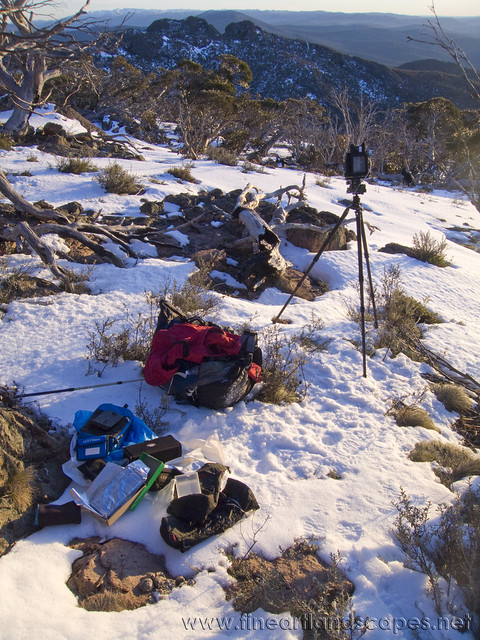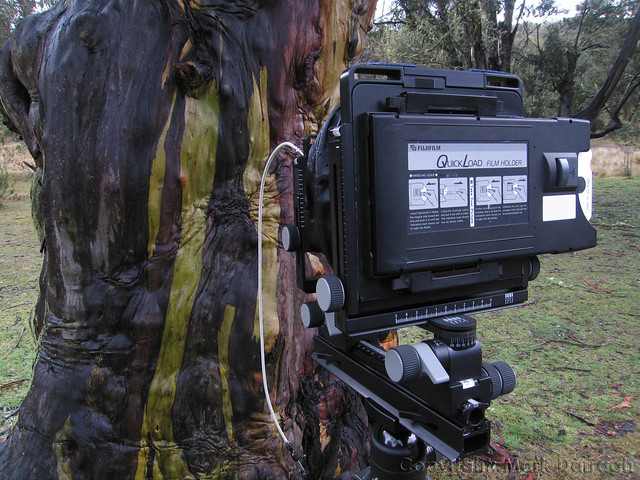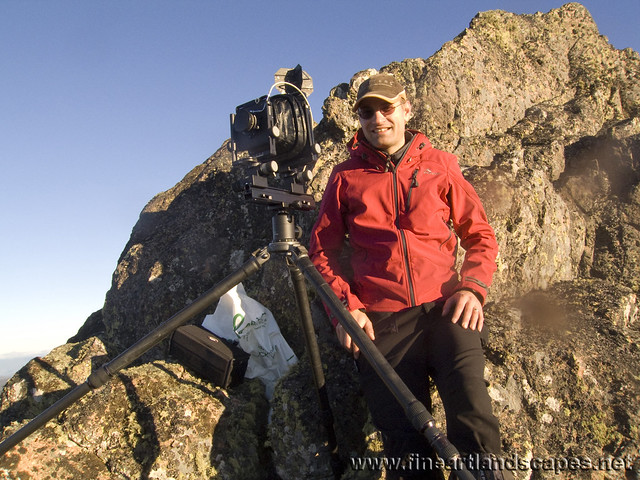Equipment
The Arca-Swiss F-Line Field in the field

Rather than being a review of the Arca-Swiss F Field per-say, this article is intended more as an account of my impressions in using the camera in a more demanding context.
Introduction
There must be at least a little madness or at least obsession at the heart of all large format landscape photographers. After all, in an age where digital cameras come standard in the smallest of mobile phones, why would anyone want lug a heavy and at times cumbersome film camera into the wilds.
The reason we do so is that a well executed large format photograph is truly a thing of beauty, with the ability to capture the very essence of a landscape.
Since 2003 the Toho FC 45-X has been my camera of choice for multi-day backpacking trips. More recently I began to use an Arca-Swiss F-Line Field, a far more robust and precise camera, for trips that don't involve overnight walking. The Arca-Swiss is over twice the weight of the Toho, even without the inclusion of accessories such as an extra bellows or extension rail. Having said all that, the ease of use of the Arca has always tempted me to try using it on a longer trip.
I finally bit the bullet in August 2011 on a trip through the Cobberas Range, a remote mountain area near the Victoria/New South Wales border. While it is not in the same class as say the epic range traverses in south west Tasmania, a five day trip through the Cobberas in winter is a much more serious undertaking than a five minute walk from a car park.
Normal I carry the Arca with the “universal” leather bellows attached, along with the extra long bellows and 40 cm extension rail. This set-up comfortably accommodates 7 lenses from 47 – 400mm and allows for close up work too. The camera lives in a custom Gnass gear bag, while lenses, accessories, film etc. live in a LowePro camera bag. All this is then placed in an 100 litre Osprey pack and fills most of that pack.
To carry the Arca on a 5 day trip required a different approach. For most of my photography I use lenses in the 80/90mm to 200mm range, therefore I chose just to carry the Arca with the universal bellows and a four lens kit (80, 150, 240, 300mm). This allowed the use of the wide angle but still enough bellows length to focus the 240 and 300mm on distant subjects.
The camera was carried as usual in it's Gnass gear case, with the telescopic rail in a separate Gnass gear sleeve. The lens were protected in a LightGear Ultra Multi Lens Case. All the camera gear along with film fitted at the top of the main compartment of my Macpac Cascade 90L pack.

Camera and associated kit, looking north from Mount Cobberas No.1
In the field
Being in mid-winter our Cobberas trip required a good deal of gear beside the camera. That of course translated to more weight in the form of a 4 season sleeping bag, extra clothing, more fuel to melt snow etc. All in all I ended up with a fairly heavy pack but given the nature of the terrain, the extra weight of the Arca kit wasn't unbearable.
The big difference came when it was time to get the camera out and photograph. Australia is not renowned for it's mountains and snow but winter in the Australian Alps still gets (relatively) cold with temperatures of -5 not uncommon overnight and in the early morning. Focussing and adjusting the movements of the Toho in these conditions is a masochistic exercise, causing considerable pain to ones fingers. By comparison, the Arca was a pleasure to use. The classic Arca F series cameras only have geared focusing but the quality of the engineering and construction means that the movements are smooth and precise. Adjusting swings and tilts with numb fingers or using gloves was so much easier compared to struggling with the screw locks of the Toho.
I was also able to take a number of detail shots during our trip. Obviously the length of bellows imposed limits on how close I could work. Using a 150mm lens allowed for a reasonable magnification and although the bellows ended up being stretched quite tight, the Arca performed admirably as expected. The rigidity of the system certainly becomes apparent in these instances and highlights the Arca's superiority to most field cameras for this kind of photography. From past experience, using my usual set-up with the extra long bellows and 40cm extension rail, even true macro work is a realistic proposition with the Arca.
There are however other cameras that have a single universal bellows which allows for both wide angle use and long extensions for close up/telephoto work. Even the humble Toho gives more flexibility in this respect. Gaining this degree of flexibility in the Arca system does require carrying an extra bellows and even rail. The drawback is space and weight.

Setting up to photograph a detail of a Black Salee trunk.

Arca-Swiss F Field with Graphmatic film holder

Ready to capture the sunset Cobberas No.1
Conclusion
For landscape photography, the Arca-Swiss F Field is justifiably a renowned camera. It's construction and ease of use make it an excellent choice for any large format landscape photographer. On this trip it proved itself more than worthy of the extra weight.
Would I carry it for ten days through the Western Arthur Range in south west Tasmania? Of course .......... if I was superhuman.
There must be at least a little madness or at least obsession at the heart of all large format landscape photographers. After all, in an age where digital cameras come standard in the smallest of mobile phones, why would anyone want lug a heavy and at times cumbersome film camera into the wilds.
The reason we do so is that a well executed large format photograph is truly a thing of beauty, with the ability to capture the very essence of a landscape.
Since 2003 the Toho FC 45-X has been my camera of choice for multi-day backpacking trips. More recently I began to use an Arca-Swiss F-Line Field, a far more robust and precise camera, for trips that don't involve overnight walking. The Arca-Swiss is over twice the weight of the Toho, even without the inclusion of accessories such as an extra bellows or extension rail. Having said all that, the ease of use of the Arca has always tempted me to try using it on a longer trip.
I finally bit the bullet in August 2011 on a trip through the Cobberas Range, a remote mountain area near the Victoria/New South Wales border. While it is not in the same class as say the epic range traverses in south west Tasmania, a five day trip through the Cobberas in winter is a much more serious undertaking than a five minute walk from a car park.
Normal I carry the Arca with the “universal” leather bellows attached, along with the extra long bellows and 40 cm extension rail. This set-up comfortably accommodates 7 lenses from 47 – 400mm and allows for close up work too. The camera lives in a custom Gnass gear bag, while lenses, accessories, film etc. live in a LowePro camera bag. All this is then placed in an 100 litre Osprey pack and fills most of that pack.
To carry the Arca on a 5 day trip required a different approach. For most of my photography I use lenses in the 80/90mm to 200mm range, therefore I chose just to carry the Arca with the universal bellows and a four lens kit (80, 150, 240, 300mm). This allowed the use of the wide angle but still enough bellows length to focus the 240 and 300mm on distant subjects.
The camera was carried as usual in it's Gnass gear case, with the telescopic rail in a separate Gnass gear sleeve. The lens were protected in a LightGear Ultra Multi Lens Case. All the camera gear along with film fitted at the top of the main compartment of my Macpac Cascade 90L pack.

Camera and associated kit, looking north from Mount Cobberas No.1
In the field
Being in mid-winter our Cobberas trip required a good deal of gear beside the camera. That of course translated to more weight in the form of a 4 season sleeping bag, extra clothing, more fuel to melt snow etc. All in all I ended up with a fairly heavy pack but given the nature of the terrain, the extra weight of the Arca kit wasn't unbearable.
The big difference came when it was time to get the camera out and photograph. Australia is not renowned for it's mountains and snow but winter in the Australian Alps still gets (relatively) cold with temperatures of -5 not uncommon overnight and in the early morning. Focussing and adjusting the movements of the Toho in these conditions is a masochistic exercise, causing considerable pain to ones fingers. By comparison, the Arca was a pleasure to use. The classic Arca F series cameras only have geared focusing but the quality of the engineering and construction means that the movements are smooth and precise. Adjusting swings and tilts with numb fingers or using gloves was so much easier compared to struggling with the screw locks of the Toho.
I was also able to take a number of detail shots during our trip. Obviously the length of bellows imposed limits on how close I could work. Using a 150mm lens allowed for a reasonable magnification and although the bellows ended up being stretched quite tight, the Arca performed admirably as expected. The rigidity of the system certainly becomes apparent in these instances and highlights the Arca's superiority to most field cameras for this kind of photography. From past experience, using my usual set-up with the extra long bellows and 40cm extension rail, even true macro work is a realistic proposition with the Arca.
There are however other cameras that have a single universal bellows which allows for both wide angle use and long extensions for close up/telephoto work. Even the humble Toho gives more flexibility in this respect. Gaining this degree of flexibility in the Arca system does require carrying an extra bellows and even rail. The drawback is space and weight.

Setting up to photograph a detail of a Black Salee trunk.

Arca-Swiss F Field with Graphmatic film holder

Ready to capture the sunset Cobberas No.1
Conclusion
For landscape photography, the Arca-Swiss F Field is justifiably a renowned camera. It's construction and ease of use make it an excellent choice for any large format landscape photographer. On this trip it proved itself more than worthy of the extra weight.
Would I carry it for ten days through the Western Arthur Range in south west Tasmania? Of course .......... if I was superhuman.